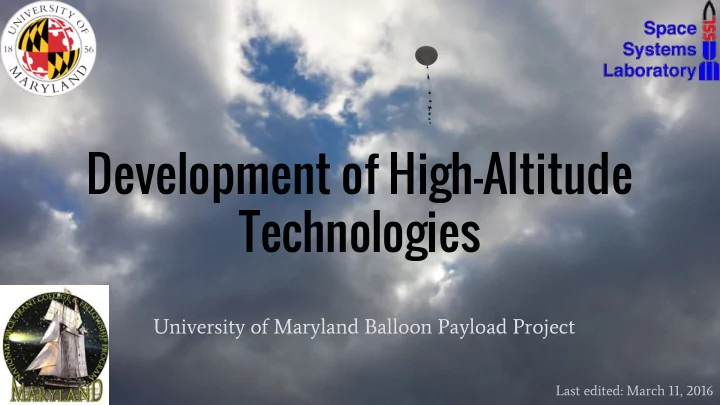

Development of High-Altitude Technologies University of Maryland Balloon Payload Project Last edited: March 11, 2016
Overview Introduction ● Supersonic ● Balloon Attitude Determination ● And Stabilization System Bach’s Box ● Tracking System ● Photo courtesy of Bach’s Box
Balloon Payload Program (BPP) Started at UMD in 2003 ● ● Funded through the MD Space grant Consortium ● Mostly undergraduates Freshman: Recruit and keep students ● interested in aerospace engineering Upperclassmen: Design and build ● meaningful flight experiments Educational outreach: ● ○ Maryland Day (April 30th) NS-50: public launches ○ Fall 2015
Typical Launch Conditions Two launches in April which ● typically start at 4:30 AM Balloon release, tracking, and ○ Rule of Ballooning: If there is a wide open field, recovery/debrief the payloads will fall on top of the tallest tree. Extreme conditions during flight: -55 ● ºC min temperature, 1kPa min pressure, 70m/s max air velocity Payloads must be lightweight and ● follow federal and University regulations 20m nylon payload string with ● parachute and a tracking module
Photos Top: TurtleNest Right: Bach’s Box
Chesapeake Bay from TurtleNest
Supersonic Designed to drop from ~75,000ft and ● reach Mach 1 during descent Many complex subsystems ● Requires high reliability ○ Redundant tracking, parachute, and ○ control systems Fiberglass exterior aerodynamic shell ● 3d printed internal structure ●
Balloon Attitude Determination And Stabilization System “Host” payload 2-axis payload stabilization system ● Uses servo motors for tilt stabilization ○ Horizontal reaction wheel for attitude stabilization ○ Tilt motors Can stabilize an arbitrary CubeSat-sized payload ● Custom carbon fiber structure ● Entire payload+host weighs only 4.5lbs ● Electronics First payload controlled by our new payload ● Box electronics platform: Balloonduino Arduino Mega compatible board with payload-specific ○ additions Reduces cost and “boilerplate” work for payloads ○ Reaction Wheel
Bach’s Box - Version 1 - Could accurately measure temperature and pressure. - Was very reliable but had difficulty with relative humidity.
Bach’s Box Specifications of Version 1 and a Vaisala RS-92D sonde
Bach’s Box - Version 4 - GPS tracking. - Multiple temperature and pressure sensors. - Weatherproof humidity sensor.
Bach’s Box - Experimental Unit (Version 3) - Multiple units - it communicates by an i2c bus. - LIDAR - tells distance away from objects up to 40m. - Sonar - resolution of objects as small as 1mm. - Ozone - our high altitude launch into the stratosphere.
Tracking Tracking required over full flight envelope of balloon ● 100k+ feet altitude ○ 30+ miles horizontal distance from base (worst case) ○ Non-line-of-sight mode below 1000 feet AGL altitude ○ Primary tracking is two redundant 2m-band (144.39 MHz) radios over APRS ● Packetized, unidirectional (air to ground) ○ ○ Operates on ametuer (HAM) frequencies - we have many licensed operators! Packets pushed to internet via ground stations ○ Secondary tracking over cellular phone network (low altitude) ● All electronics run on Arduino platform ● Ground functions coordinated from lead chase van ●
Tracking - APRS Ground Stations From aprs. fi
Tracking - Next Steps Live bi-directional communication ● APRS is sparse and one-way ○ Bi-directional necessary for some in-development payloads ○ Continuous, real-time telemetry could open up new avenues of design ○ Custom telemetry software ● Helpful in enabling bi-directional communication ○ ○ Allows better visibility into tracking data Could drive steerable antenna - better reception ○
Tracking - Pictures
Typical Launch Schedule Friday afternoon Pick up vans ● Final ground track & weather predictions ● Launch decision: Sat or Sun ● Flight readiness review of all payloads ● Saturday morning NS -51 Pizza Debrief 430am - meet at SSL and load vans for 5am departure ● 7am - gather in Clear Spring, MD, for payload string assembly ● 8am - balloon inflation & final payload closeout ● 830am - balloon release then all tracking vehicles load up and chase ● 10am - payloads land somewhere (MD, PA, WVa, VA) ● 11am - payloads tracked and found, usually in the top of tallest tree ● 1pm – eat lunch at Pizza place and debrief ●
Contributions of BPP Opportunities for paid undergraduate engineering experience ● This program has gotten our name out there. ● ○ CanSat Win, NFB Coverage, Altitude Record, CO Workshops Outreach to Comm Colleges, and High Schools ● Faculty at other schools rely on our launch capability ● ○ UMCP, UMBC, UMES Morgan State University, Hagerstown Community College ○ ○ Capitol Technology University, Carver Center High School Increased enthusiasm for and understanding of engineering ● Past Balloon Program leaders now working at JPL and SpaceX ●
Thank you! Any questions? @UMDNearspace
Recommend
More recommend